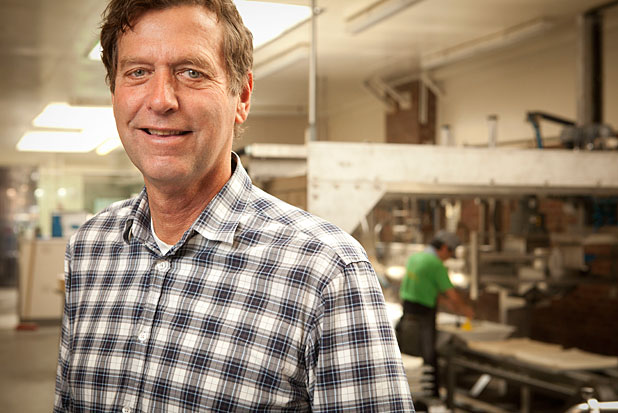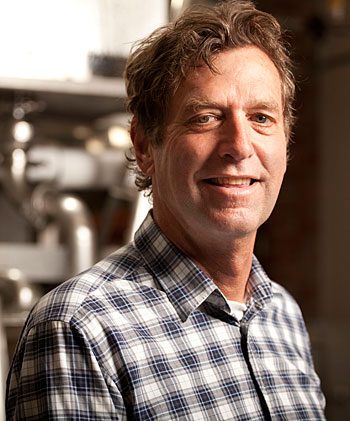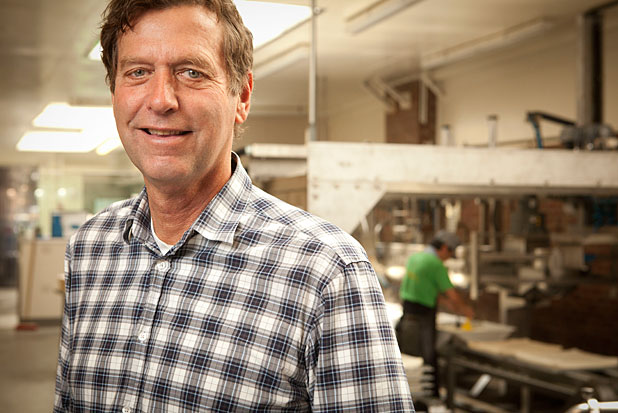 John Scharffenberger at the Hodo Soy Beanery tofu factory in Oakland, Calif.(Bart Nagel Photography)
John Scharffenberger at the Hodo Soy Beanery tofu factory in Oakland, Calif.(Bart Nagel Photography)
This is the first in Grist’s series of interviews with a group we’re calling the “New Agtivists” — the many people who’re working to change this country’s f’ed-up food system. Whether famous or un-, they’re a little bit country and a little bit punk rock. They’re starting urban farms, seed-saving ventures, and underground food-swapping markets. They’re fighting for better food in schools and fewer feedlots. They have one thing in common: they think food matters — and they’re taking it into their own hands to improve how it is produced and consumed in this country. We think you’ll be inspired by their stories.
We’re starting with someone near the top of the food chain: John Scharffenberger, 58, who before founding the chocolate company for which he became famous, made California sparkling wine. In both cases, he was one of the first Americans to find success in what had been a European-dominated market niche. (Fun fact: Ronald Reagan and Mikhail Gorbachev used his bubbly to toast the end of the Cold War.) In 2005, much to the chagrin of conscientious chocolate fans everywhere, he and his partner sold Scharffen Berger Chocolate Maker to Hershey. Since then, Scharffenberger’s dabbled in this and that, as both an adviser and producer: he’s partnering with a Northern California grass-fed beef rancher to raise hogs and fatten them on acorns for Ibérico ham, and he’s making his own sauerkraut and selling it through the grassfed-beef hot-dog maker Let’s Be Frank.
Last week, Hodo Soy Beanery, a small organic-tofu maker in Oakland, Calif., announced it had snagged Scharffenberger to be its CEO. (Disclosure: I regularly buy — and love — Hodo’s tofu at the Berkeley farmers markets.) I called Scharffenberger this week to ask him about this latest career move, why he sold the chocolate business, and who’s inspired him over the years.
Q. First sparkling wine, then chocolate, sauerkraut, Ibérico ham, and now tofu. What’s up with you and fermented foods?
A. Well, first, tofu is not fermented. It is coagulated, and there are fermented forms, but Hodo doesn’t do those. But I am fascinated by fermentation. It does wonderful things to foods. When it comes to taking preserving stuff to the next level, all the traditional methods involve modification through fermentation.
I am currently quite interested in sauerkraut. I was just out looking at my cabbages this morning. I’m taking it from the ground level up, which is what I like to do. So I’m growing all the cabbages I use, from the varieties I want for a consistent flavor profile. That’s very important to me.
Q. How did you get involved with Hodo Soy Beanery, and why?
A. I was at the Berkeley farmers market and saw these interesting noodles, the five-spiced ones Hodo makes. I had a sample and was like “Oh my god, these are delicious, what’re they made from?” I was surprised to hear they were soy, made from the skin of soymilk. I talked to them for a while.
Some time went by. [Founder and tofu master] Minh Tsai was in the middle of building the factory and needed help at the board level. So I joined the board. It seemed to me that they needed help with the next step — focus and coordination — to grow. I know that when you’re super-creative, you have a hard time focusing on product selection and making sure the product and the marketplace and the distribution system are all in balance so that you don’t make too many interesting things and go out of business because you forget to sell them. I just thought: I can help with that. They’re doing amazing stuff: it deserves an audience; let’s get it out there.
Q. I know we love tofu here in the Bay Area, but is there really a big market for fresh, artisanal tofu outside here?
A. I think so, I think we can grow to 6 to 10 times the current distribution to serve the entire West Coast. We’re going to look at different nodes of production. We work with small cooperatives in the Midwest that grow organic and non-GMO soy. Maybe we would go to Chicago or Iowa and actually make the tofu there, to be closer to them. Also I am very impressed with the traction that friends of mine are getting with Meat-Free Mondays in the UK. The English seem more conscious about their imprint and the amount of the meat that we consume.
Q. And how does that fit in with your Ibérico ham business?
A. If all the meat I had to eat came from Food Inc. I’d become a vegetarian. But I know where it all comes from. I eat chickens from my own property — my family and two others share 12 hens, a duck, and a rooster. My beef and pork comes from Mac Magruder [his pork-raising partner].
Q. Tell me about this interesting-sounding major you had at UC Berkeley, biogeography.
A. I had to write it myself, through the geography department. I really wanted to be in agricultural land planning. I looked through all the agricultural courses and put them altogether into a cogent study of biology, plant pathology, botany, soil science, hydrology, geology. And so the geography department said “OK, we’ll take that,” and they called it biogeography, but it was very slanted toward agricultural geography.
Q. How’d you get from that into food?
A. I was working summers — this was back in the old days of biodynamics, with raised beds and proper planting — in Santa Cruz. My friends there were all acolytes of [the influential biodynamic and organic master gardener] Alan Chadwick’s. I worked at a this tiny little winery that was really organized, the first French-style winery in California, called Stony Hill. It was run by these staunch Democrats who were amazing horticulturists. That’s who got me interested in the wine business. They were really good mentors who propelled me into the kind of agriculture I was able to practice later.
Q. So you got into food via farming.
A. Yeah. It wasn’t about fancy restaurants — it was about dirt.
Q. Why did Scharffen Berger chocolate make a point of identifying its ingredients as non-GMO, organic, etc.?
A. Look, Robert [Steinberg, his cofounder] graduated from high school in 1966; I did in 1969. I knew people who kidnapped Patty Hearst. We grew up with this stuff before it was a marketing thing. Likewise, we were going back to origins in chocolate before it was a marketing thing. It was an ingrained ethic for us.
Q. Which is why a lot of people were pretty bummed when you sold the business to Hershey. Why did you?
 John Scharffenberger(Bart Nagel Photography)A. They came to us with a crazy amount of money. Robert had health problems. I had about 23% of the stock; I had no control over the outcome. I dragged my feet for as long as I could. Robert wanted to sell, most of the board wanted to sell. At the end of the day, they doubled the price and I would have been an asshole not to say yes.
John Scharffenberger(Bart Nagel Photography)A. They came to us with a crazy amount of money. Robert had health problems. I had about 23% of the stock; I had no control over the outcome. I dragged my feet for as long as I could. Robert wanted to sell, most of the board wanted to sell. At the end of the day, they doubled the price and I would have been an asshole not to say yes.
Q. Do you still eat the chocolate?
A. Oh yeah! They are making some really good single-origin stuff. They don’t know how to market it though.
Q. Who inspires you?
A. [Food system journalist] Michael Pollan, though I don’t agree with everything he says. I love his energy about explaining things. [Kitchen scientist] Harold McGee; I really like him. There are ton of gardeners I think are amazing.
Q. Name a book or two that you return to over and over.
A. McGee’s On Food and Cooking, and Julia Child’s The Way to Cook.
Q. What’s your earliest food memory?
A. My mom was a really good cook. Not fancy, we never had a canned or frozen vegetable — though I hated vegetables. Honestly, my favorite thing was a really good bakery roll with a lot of poppy seeds — a hardroll they call them back East — with fresh butter from my dad’s farm.
Q. Your dad had a farm?
A. Just briefly, then he went bankrupt — took him 20 years to pay it off.
Q. Do you have a junk-food weakness?
A. I like chili dogs. I try to eat Lets Be Frank dogs … but I think all hot dogs are great. I never go to New York without getting a street dog. With sauerkraut.
Q. Company drops by unexpectedly around dinnertime. What do you do?
A. I open a bottle of wine and say sit down, relax, this will take a while. Then I walk straight out to my garden. If it’s winter, they get a lot of kale and leeks. I always have food here. I grow maybe half the food I eat, maybe more. I’m big on omelets and souffles.
Q. What keeps you up at night?
A. I sleep really well. That’s the nice thing about working with people you like and trying to do everything as well as you can.
Q. What? You don’t lie awake thinking about climate change and the oil spill like the rest of us?
A. Oh, the world’s a mess! A total mess! And it’s been a mess since I was a kid. I think you become much more Buddhist as you get older. You shouldn’t complain about things you don’t control. I certainly vote and am involved in the electoral process, but mainly I try to make what I do benefit people.
I speak a lot at business schools, and I ask how many people are there to make money. And then I say why don’t you just quit school and be drug dealers then? Because business school is about making things for people. That’s why you should be here.


